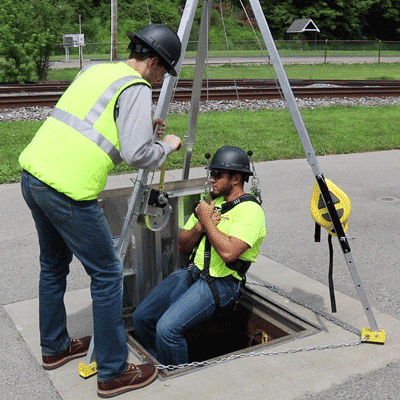Confined Space & Safety Systems
Working in a confined space comes with many hazards. Falls in confined spaces are particularly dangerous as, unlike falls in open areas, a confined space severely limits how a rescue can be conducted. Not only are rescuers limited by how they can access a fallen or injured worker, but they are also presented with fewer options on how to retrieve them.
When it comes to confined space entry, your options for safety equipment can be somewhat limited. The two most common systems for confined space entry are Davit Systems and Tripod Systems. While other options exist, they are either incredibly specialized or site-specific. In this article, we will be focusing on Confined Space Tripod Systems, how they are used in confined space applications and the potential benefits and limitations that come with them.
The primary goal of any confined space system is to facilitate the safe entry and exit of the spaces they operate on. This is achieved by providing secure descent control in locations without a primary means of entry, and a rescue system capable of lifting and lowering a fallen worker. Tripod systems meet these requirements thanks to the anchor points they provide. Both rescue units and work winches are able to be secured to the legs of the tripod system. The lines from these units are anchored to points at the head of the tripod directly above the point of entry for maximum stability.
Pros Of Using A Tripod System

A major benefit of tripods is their ease of use. Tripods like the TP7 consist of a single fully assembled unit. With no need to separately store and assemble components, tripod systems are the grab-and-go choice for general-use confined space safety equipment. Thanks to their simplicity, it is easy to train workers how to properly use them. With fewer removable components, tripods are easier to transport and maintain than other confined space safety solutions. Additionally, tripods have also been the standard choice for confined space systems in many industries and are familiar to most work crews. Cost is another aspect of tripod systems that many in need of a confined space system consider. Generally, tripods are more cost effective than other systems, again due to the fact that they have simpler components.
Cons Of Using A Tripod System
While tripod systems are a great solution to many confined space entry needs, there are some use cases where a tripod won’t meet the necessary requirements to ensure safe operations. In situations where factors such as available space, uneven work surfaces, and non-vertical applications are present, a tripod is not the best choice. Attempting to use a tripod in scenarios with these factors present can result in serious workplace accidents. Using a tripod in a non-vertical application or on uneven ground can result in the system becoming off-balance and tipping. In these situations, specialized equipment or other confined space systems such as davit systems are better suited.
In Short
If you are working over a confined space and
- Have a level workspace.
- Are working in vertical applications.
- Want an effective low cost solution.
- Have no workplace conditions that would warrant specialized equipment.
Then a tripod system might be the right pick for you.
Staying Safe With Proper Training
Regardless of what systems you use, it’s important to understand the dangers that confined spaces represent. Every work environment has unique hazards. Knowing how to deal with these hazards is what keeps workers safe, not just the equipment they use. While we don’t enjoy the discussions and statistics around workplace injuries and fatalities, it is important we keep them in mind. Every number on the linked charts provided by The U.S. Bureau of Labor Statistics was a worker whose death was a result of confined spaces and the dangers within. It is the job of both onsite workers, supervisors, and trained rescue personnel to ensure that hazards are approached with caution. Training is the first step to a safer workplace. Stop by our training page to see our available courses.